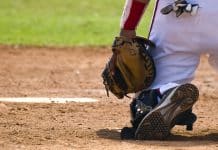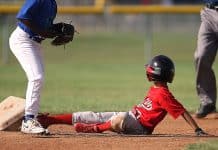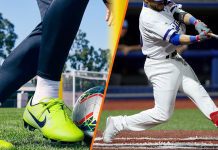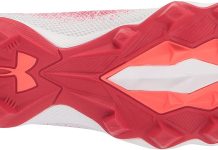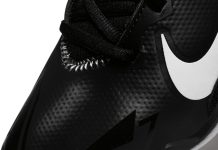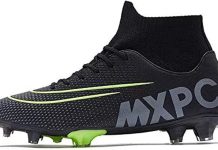Baseball cleats and sneakers, two styles of footwear that have become synonymous with sports and comfort. But do they fit the same? Many sports enthusiasts have pondered this very question. In this article, we will explore the similarities and differences between baseball cleats and sneakers in terms of fit, providing you with all the necessary information to make an informed decision when it comes to choosing the right footwear for your next game or casual outing. So lace up your shoes and let’s dig into the world of baseball cleats and sneakers!
Anatomy of Baseball Cleats
Review contents
Design and Construction
Baseball cleats are specially designed footwear that is specifically made for playing baseball. They are constructed to provide maximum performance, support, and traction on the field. The design of baseball cleats is focused on enhancing the player’s ability to run, change direction, and maintain stability while playing the game. The construction of baseball cleats typically involves a combination of synthetic materials, leather, and rubber to create a durable and comfortable shoe.
Materials Used
The materials used in baseball cleats play a crucial role in their overall performance and durability. The uppers of the cleats are often made from synthetic materials or leather. Synthetic uppers are lightweight and offer excellent breathability, while leather uppers provide durability and a classic look. The outsoles of baseball cleats are typically made from rubber or a mixture of rubber and metal spikes. Rubber outsoles provide good traction on most playing surfaces, while metal spikes are used for enhanced traction on soft grass or dirt fields.
Features and Support
Baseball cleats are designed with specific features and support mechanisms to meet the demands of the game. They often have reinforced toe boxes and heel counters to provide protection and stability to the player’s feet. Cleat patterns and configurations are strategically placed on the outsole to ensure maximum traction and grip on various terrains. Additionally, many baseball cleats offer cushioning and shock absorption technologies to reduce the impact on the player’s joints and muscles during running and quick movements.
Variations in Styles and Types
There are various styles and types of baseball cleats available on the market to cater to different player preferences and field conditions. Low-top cleats provide increased mobility and flexibility, making them suitable for players who require agility. Mid-top cleats offer a balance between mobility and ankle support, ensuring stability during quick lateral movements. High-top cleats provide the most ankle support, reducing the risk of ankle injuries. Additionally, there are molded and metal cleats available, with metal cleats offering superior traction on softer playing surfaces.
Differences between Baseball Cleats and Sneakers
Function and Performance Requirements
Baseball cleats and sneakers serve different purposes and have distinct performance requirements. While sneakers are designed for everyday casual wear and general athletic activities, baseball cleats are specifically engineered to enhance performance in baseball. Cleats are designed with features that optimize traction, stability, and support for the specific movements and requirements of the game, such as running, fielding, and quick changes in direction. Sneakers, on the other hand, focus more on overall comfort and versatility for various sports and activities.
Spike Configuration and Traction
One of the major differences between baseball cleats and sneakers is the spike configuration and traction. Baseball cleats commonly feature studs or spikes on the outsole, which are designed to dig into the playing surface and provide enhanced traction and grip. The spike configuration varies depending on the type of playing surface, with metal spikes being more suitable for grass or dirt fields and molded spikes or rubber cleats being used on artificial turf or harder surfaces. In contrast, sneakers typically have a flat, non-marking outsole with patterns or grooves that provide grip and traction on different surfaces.
Flexibility and Weight
Flexibility and weight are also distinguishing factors between baseball cleats and sneakers. Baseball cleats are often stiffer in order to provide stability and support during quick movements and changes in direction. This stiffness helps prevent injuries and enhances performance on the field. Sneakers, on the other hand, are typically more flexible to allow for natural foot movement and adaptability to different activities. Additionally, baseball cleats are generally heavier due to the sturdier construction and additional features required for the game, while sneakers prioritize lightweight designs for enhanced comfort during everyday wear.
Durability and Longevity
Baseball cleats and sneakers also differ in terms of durability and longevity. Baseball cleats are designed to withstand the rigors of the game, with reinforced materials and construction to endure frequent use on various playing surfaces. The outsoles of baseball cleats, especially those with metal spikes, may wear down over time and require replacement or repair. Sneakers, on the other hand, are generally not subjected to the same level of wear and tear as baseball cleats, as they are primarily used for casual wear and a range of low-impact activities.
Considerations When Buying Baseball Cleats
Fit and Sizing
Proper fit and sizing are crucial when purchasing baseball cleats to ensure optimal performance and comfort on the field. It is important to measure your feet accurately and choose a size that provides enough room for your toes while keeping your feet securely in place to prevent sliding or discomfort. When trying on cleats, it is recommended to wear the same socks that you would wear during a game to ensure an accurate fit.
Purpose and Playing Surface
Consider the purpose of the cleats and the type of playing surface you will most often encounter. Different cleat styles and configurations are designed for specific purposes and playing conditions. Molded cleats are more versatile and suitable for a variety of surfaces, while metal cleats offer superior traction on softer fields. Turf shoes are designed specifically for artificial turf surfaces. Choosing the right cleats for your playing surface will enhance your performance and prevent potential injuries.
Injury Prevention
Baseball cleats should provide appropriate support and stability to help prevent common baseball-related injuries. Look for cleats with reinforced toe boxes and heel counters to protect against impact and provide stability during quick movements. Ankle support is also crucial to reduce the risk of sprains or strain. Consider your playing style and any past injuries to select cleats that provide the necessary support for your specific needs.
Comfort and Support
Comfort and support are key factors to consider when purchasing baseball cleats. It is important to choose cleats that feel comfortable from the moment you try them on. Look for cleats with cushioned insoles or padding for added comfort. The cleats should also provide adequate arch support to prevent fatigue and discomfort during long periods of play.
Maintenance and Care
Proper maintenance and care of baseball cleats can significantly extend their lifespan and performance. Regularly clean the cleats after each game or practice to remove dirt and debris. Allow them to air dry thoroughly before storing them in a well-ventilated area. Inspect the cleats periodically for any signs of wear or damage, such as loose spikes or torn uppers. Replace worn-out spikes or damaged cleats to maintain optimal performance and prevent potential injuries.
Choosing the Right Size of Baseball Cleats
Importance of Proper Sizing
Choosing the right size of baseball cleats is essential to ensure comfort, performance, and injury prevention. Wearing cleats that are too small can cause discomfort, blisters, or even foot pain, while cleats that are too large may lead to instability, poor traction, and an increased risk of injury. Properly fitting cleats provide adequate support, allow for natural foot movement, and help maintain stability on the field.
Measuring and Fitting Techniques
To determine the proper size of baseball cleats, it is important to measure your feet accurately. Use a ruler or measuring tape to measure the length of your foot from the back of the heel to the tip of your longest toe. Repeat the process for both feet, as there may be slight differences in size. Use the larger of the two measurements when selecting your cleat size. Most cleat manufacturers provide size conversion charts that correlate foot length with cleat sizes.
Trying on Different Brands and Models
Different brands and models of baseball cleats may have slightly different sizing or fit characteristics. It is recommended to try on cleats from various brands and models to find the one that fits your foot shape and size the best. Pay attention to how the cleats feel when walking or running, ensuring they provide ample room in the toe box, a snug fit around the midfoot, and good ankle support.
Consideration of Foot Shape and Arch
The shape of your foot and the type of arch you have can also influence the fit and comfort of baseball cleats. Some cleats are designed for players with high arches, while others are more suitable for those with flat feet. Consider your foot shape and arch type when choosing cleats to ensure the best possible fit, support, and overall comfort.
Fit Adjustments for Socks and Insoles
Keep in mind that the thickness of your socks or the use of orthotic insoles may affect the fit of baseball cleats. If you typically wear thicker socks during games, it may be necessary to select cleats that provide a slightly roomier fit to accommodate them. Similarly, if you wear orthotic insoles for additional support or cushioning, consider their thickness when choosing the right size of cleats.
How to Determine the Proper Fit
Length and Toe Room
When determining the proper fit of baseball cleats, pay attention to the length of the shoe and the amount of toe room provided. There should be enough space at the front of the cleats to wiggle your toes comfortably, but not so much room that your foot slides forward within the shoe. Make sure your toes are not touching or pressing against the front of the cleats, as this could lead to discomfort, blisters, or nail injuries.
Width and Heel Support
Consider the width of the cleats and ensure that they provide a snug fit around the midfoot without feeling too tight or constricting. Cleats that are too narrow can cause discomfort and restrict natural foot movement, while cleats that are too wide may result in instability and a lack of support. Additionally, the cleat should provide proper heel support to prevent slipping or sliding during quick movements and changes in direction.
Midfoot and Arch Area
The cleats should provide adequate support and a secure fit around the midfoot and arch area. Check for any pressure points or areas of discomfort that may indicate an improper fit. Cleats that are too tight in this area can cause pain and restrict blood circulation, while cleats that are too loose may result in instability and reduced performance.
Ankle Stability and Lacing Configuration
Ankle stability is crucial for preventing injuries and maintaining balance on the field. Ensure that the cleats provide sufficient ankle support without causing discomfort or restricting natural ankle movement. The lacing configuration of the cleats can also affect the fit and support around the ankle. Experiment with different lacing techniques to find the most secure and comfortable fit for your specific needs.
Breaking in Baseball Cleats
Importance of Breaking in
Breaking in new baseball cleats is crucial to ensure optimal comfort and performance. New cleats often have stiff materials that need time to mold and adjust to the shape of your feet. By breaking them in gradually, you give the cleats an opportunity to conform to your feet and reduce the risk of discomfort, blisters, or other potential issues during actual gameplay.
Gradual Wear and Adaptation
Start by wearing your new cleats for short periods of time, gradually increasing the duration as your feet adjust to the shoes. Begin with wearing them for casual activities or light practice sessions before using them in intense gameplay. This allows the materials to gradually soften and adapt to your movements, increasing overall comfort and reducing the risk of discomfort or blisters.
Stretching Techniques
If you find certain areas of the cleats to be particularly tight or uncomfortable, you can try various stretching techniques to alleviate the pressure points. One technique is to use a shoe stretcher, which can gently expand the material and provide additional room in specific areas. Another method is to stuff the cleats with wet newspaper or socks and let them air dry. As the material dries, it stretches slightly, providing a more comfortable fit.
Wear Test and Field Practice
After the initial breaking-in period, it is important to test the cleats on the field to ensure they provide the desired comfort and functionality. Use them during practice sessions to get a feel for how they perform during running, cutting, and other movements specific to baseball. Take note of any areas of discomfort or potential issues that may arise and address them promptly.
Common Break-in Problems and Solutions
During the breaking-in process, some common issues might arise, such as blisters, discomfort, or pressure points. It is important to identify and address these problems to ensure a proper fit. Applying moleskin or athletic tape to areas prone to blisters or discomfort can provide temporary relief. Additionally, consulting with a professional shoe fitter or podiatrist can help in resolving any persistent or severe break-in problems.
Potential Issues with Ill-Fitting Cleats
Reduced Performance and Athleticism
Wearing ill-fitting cleats can significantly impact your performance and athleticism on the baseball field. Tight or constricting cleats can restrict natural foot movement and agility, making it difficult to run, change direction, or field the ball effectively. Loose cleats, on the other hand, can lead to instability and lack of support, affecting your ability to perform at your best.
Increased Risk of Injuries
Improperly fitting cleats can increase the risk of injuries during gameplay. Shoes that are too tight can cause blisters, calluses, or nail injuries, while shoes that are too loose may result in ankle sprains or other foot and ankle injuries. The lack of proper support and stability can also contribute to injuries, especially during quick movements or sudden changes in direction.
Discomfort and Pain
Wearing cleats that do not fit properly can cause discomfort and pain, affecting your overall enjoyment of the game. Areas of pressure or tightness can lead to foot pain, which can have a negative impact on your performance and ability to focus. It is important to address any discomfort or pain promptly by seeking a better-fitting pair of cleats.
Blisters, Calluses, and Corns
Ill-fitting cleats can cause friction and pressure points on the feet, leading to the development of blisters, calluses, and corns. These issues can be painful and may require additional treatment, such as applying protective coverings or seeking professional foot care. Properly fitting cleats can help prevent the formation of these common foot ailments.
Impact on Long-Term Foot Health
Wearing shoes that do not fit properly, especially for prolonged periods, can have long-term consequences for foot health. Constant pressure, tightness, or rubbing can lead to deformities, such as bunions or hammertoes. Additionally, poor alignment and lack of support in ill-fitting cleats can contribute to foot and ankle issues, such as overpronation or instability. Investing in properly fitting cleats is essential for maintaining foot health and preventing potential long-term complications.
Tips for Ensuring Proper Fit
Get Professional Advice and Measurements
If you are unsure about the proper fit of baseball cleats or have specific foot concerns, it is advisable to seek professional advice from a reputable shoe fitter or podiatrist. They can accurately measure your feet, assess your foot type and any specific needs, and suggest suitable cleats that provide the necessary support and fit for your individual requirements.
Consider Personal Preference and Playing Style
While it is important to prioritize proper fit and support, personal preference and playing style should also be considered. Some players may prefer a snugger fit for enhanced control and responsiveness, while others may prioritize a slightly roomier fit for added comfort. Additionally, consider your playing position and the specific demands of your role on the field when selecting cleats.
Try On and Compare Multiple Options
Do not be afraid to try on multiple brands, models, and sizes of baseball cleats before making a final decision. Comfort and fit can vary significantly between different brands and models, so it is important to explore various options to find the one that suits you best. Walk or run in the cleats to assess their overall comfort, support, and fit, and compare them side by side to make an informed choice.
Pay Attention to Different Brands and Models
It is worth noting that different brands and models of baseball cleats may fit differently, even if they are labeled with the same size. Each brand may have its own unique sizing chart or design characteristics that can affect the fit and comfort. Therefore, it is advisable to avoid assuming that your usual size in one brand will automatically be the same in another. Always try on each pair of cleats individually to ensure the best fit.
Seek Feedback and Reviews from Players
Taking the time to research and seek feedback from other baseball players can provide valuable insights into the fit and performance of different cleat models. Online reviews, forums, or talking to experienced players can help you gather information about the pros and cons of certain brands or models. Feedback from other players can supplement your own experience and assist in making an informed decision.
Maintenance and Care of Baseball Cleats
Cleaning and Drying
Proper cleaning and drying of baseball cleats after each use is essential for their longevity and performance. Remove any excess dirt or debris from the cleats using a soft brush or cloth. Use a mild detergent or cleaning solution and a clean cloth or sponge to gently wipe down the uppers and outsoles. Rinse off any soapy residue with clean water and pat the cleats dry with a towel. Allow the cleats to air dry completely before storing them.
Storing and Traveling
When not in use, store your baseball cleats in a cool, dry place away from direct sunlight. Avoid placing them in a warm or humid environment, as this can damage the materials or cause them to deteriorate faster. It is also advisable to store cleats in a shoe bag or separate compartment to prevent them from getting crushed, scratched, or mixed with other items. When traveling, protect the cleats by packing them in a shoe bag or wrapping them in a soft cloth or towel.
Replacing Worn Cleats or Inserts
Over time, the spikes on the outsoles of baseball cleats may wear down or become damaged. Inspect the spikes regularly for any signs of wear or damage, and replace them as necessary. Replacement spikes can be purchased from sporting goods stores or online. Additionally, if the insoles of the cleats become worn out or lose their cushioning, consider replacing them with new insoles to ensure optimal comfort and support.
Periodic Inspections and Repairs
It is important to periodically inspect your baseball cleats for any signs of wear, damage, or deterioration. Check the uppers, outsoles, stitching, and any other components of the cleats for weaknesses or potential issues. Address any repairs promptly to prevent further damage and extend the lifespan of the cleats. Damaged areas can often be patched or repaired by a professional shoe repair service, depending on the extent of the damage.
Conclusion
Baseball cleats and sneakers serve different purposes and have distinct design and construction features. While sneakers are versatile, baseball cleats are specifically designed to enhance performance, traction, and support on the field. When purchasing baseball cleats, proper fit, support, and comfort are crucial considerations. Remember to measure your feet accurately, try on multiple options, and consider personal preferences and playing style. Taking care of your baseball cleats through regular cleaning, proper storage, and timely repairs will ensure their longevity and performance. By paying attention to these essential factors, you can find the perfect pair of baseball cleats to enhance your game and enjoy playing your best.




